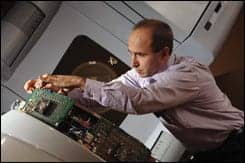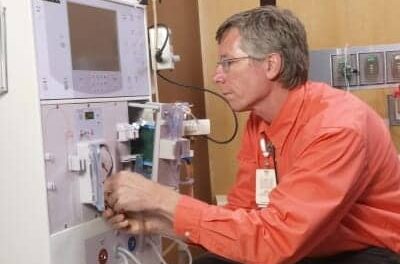By Aine Cryts
What sets apart Eskenazi Health’s biomedical engineering department is its focus on service, planning, and the ability of the entire team to pitch in and get the job done, says Matthew Royal, director of biomedical engineering. Royal took over the role of director three years ago. As excited as he was—and still is—in the role at the Indianapolis-based health system, he’s also building on a legacy created by his former manager, Dan Dudley.
Royal had worked with Dudley when he started in his career in clinical engineering at Eskenazi Health—then known as Wishard Memorial Hospital—14 years ago. That’s back when he started in an entry-level role as repair assistant. He calls it an honor that he was hired back to Eskenazi Health to serve in his former manager’s role.
As much respect as Royal still has for his former manager’s legacy, there are also ways he wants to shape the department in his role as a leader.
Contingency Planning and Customer Service
Two areas where Royal’s team sets the bar high is in contingency planning and customer service. “One of the easiest ways to keep your customers happy is to get them back into service quickly [if a device is broken],” says Royal.
Helping that clinician can mean finding a replacement device or ensuring the repaired device is available as soon as possible. Making sure his clinicians have the tools they need doesn’t mean Eskenazi Health has a “warehouse of backup equipment,” says Royal.
What it does mean is he uses a variety of analytical tools to ensure the utilization of all of the health system’s biomedical equipment. That contingency planning includes the use of an operational risk score to enhance his team’s evaluation.
Royal distinguishes his team’s approach with that practiced in many clinical engineering teams at hospitals around the country—most of which don’t include available backup equipment, mean time between failure, and utilization as part of their equipment maintenance strategy.
Managerial Philosophy
Royal says with candor that he wants to train the best possible team so that he can be replaced one day. And that, too, draws on his former manager’s reputation for developing the best possible clinical engineering team.
“I want to build a culture where people know they have a career. If they outgrow this hospital and end up in leadership someplace else, I want to feel like I’ve helped them in their career,” he says.
Royal notes that the biomedical engineering team has such a good reputation for fostering great talent that other facilities consider Eskenazi Health’s employees the “best of the best.” Mentoring is also near and dear to Royal’s heart—as it was for his predecessor.
He looks back with fondness on his first day at what he affectionately refers to as “the old Wishard.” His first day on the job, he witnessed Jim Kempf, an experienced clinical engineer, and Dudley, his former manager, doing the same work expected of anyone else on the team—even someone with as little experience as he had back then.
Today, Royal describes his team as a mix of long-term employees—some of whom have been around for 35 years or more—and others who have been on the team for two years. While the veteran team members have more technical experience, it’s their mentoring skills that really make them shine, he adds.
Coordination Among Departments
Whether it’s working closely with his colleagues in emergency management to prepare for a natural disaster or heading off a cyberattack—or in his cross-functional approach to the purchase of new capital equipment—Royal’s team is relied upon as a source of expertise and coordination by his colleagues throughout Eskenazi Health.
For example, if the health system needs a new CT scanner, the biomedical engineering team has a pivotal role to play in coordinating with other teams, such as design and construction, facilities, clinicians, information technology, and supply chain management (or purchasing at other healthcare facilities).
This level of planning and coordination is required in today’s world, Royal points out. For instance, the information technology team must ensure that any new CT scanner integrates with the institution’s EHR, and the facilities team needs to ensure the appropriate space and access to electrical power for the new piece of equipment.
Royal’s advice for clinical engineering leaders when it comes to staving off cyberattacks? “Don’t push it off on your IT team.” As is the case at hospitals around the country, his team is responsible for the healthcare facility’s medical devices, which means Royal must educate himself on best practices to ensure network security.
Building Relationships
As important as supporting members of his team is to Royal, he considers it equally important to build relationships with other teams across the healthcare facility. It’s because he values these personal and professional relationships that other teams are aware of biomedical engineering—and, in turn, that he knows which team he should engage with if it needs a new electrical outlet, for example.
In that instance, he’d tap an electrician on the facilities team. “I could certainly put in a work ticket to get that done, but it’s much better to open those lines of communication with other departments,” he says.
The best way to nurture and build these cross-departmental relationships is by having regular meetings with other teams throughout the healthcare facility, recommends Royal.
Patient-Focused
Because of its role as a level-1 trauma center, Eskenazi Health is relied upon by the community, says Royal. That’s why it’s so important to coordinate and build relationships with other teams.
If, for example, there were a disaster outside the facility, he would need to work with his colleagues to determine the number of beds available to patients. Or if a disaster impacted the healthcare facility itself, he would have a key role in determining when employees and patients needed to evacuate.

Matt Dimino, an Eskenazi Health radiology service technician-I.T., reviews imaging quality on a CT scanner.
Planning is important here. Royal notes that he’s very active in developing the health system’s disaster plan—and he also works closely with his emergency management colleagues on exercises several times a year to ensure that all employees are aware of what to do in the event of an emergency.
One previous exercise involved what the facility would do if there were a water shortage. Since water is required for steam, which is used in the sterilization of medical equipment, team members throughout the health system need to be mindful of what this means for patient care—and what it takes to get all systems up and running as soon as possible.
Academic Connections
The biomedical engineering team works closely with the healthcare engineering technology management program at Indiana University Purdue University Indianapolis on internships and volunteer opportunities. The biomedical engineering team also hosts classes onsite at the hospital.
Hands-on training, mentorship, academic professionalism, and the ability to interact with clinicians and members of management are some of the key skills students gain from this partnership, adds Royal.
“As part of this relationship between the hospital and the university, students not only work in a clinical environment, but [they also] are offered an opportunity to work with tools of the trade, get exposure to vendors, documents, policies, procedures, and engage real situations to foster learning experiences.”
Real-World Impact
Royal describes the opportunity to work at Eskenazi Health as “really special.” “We’re the county hospital,” he says. “We get everybody here, including the underserved; our service to the poor is a real value our organization brings. We see it every day.”
And this connection to local community members, perhaps, is the biggest benefit of all. “It truly makes you see that you’re making an impact on our local community, especially in our new hospital…this new hospital is really what our community deserves to have,” Royal says. “They have access to the best quality healthcare, and our new building reflects that.”
Aine Cryts is a contributing writer for 24×7 Magazine. Questions and comments can be directed to [email protected].








